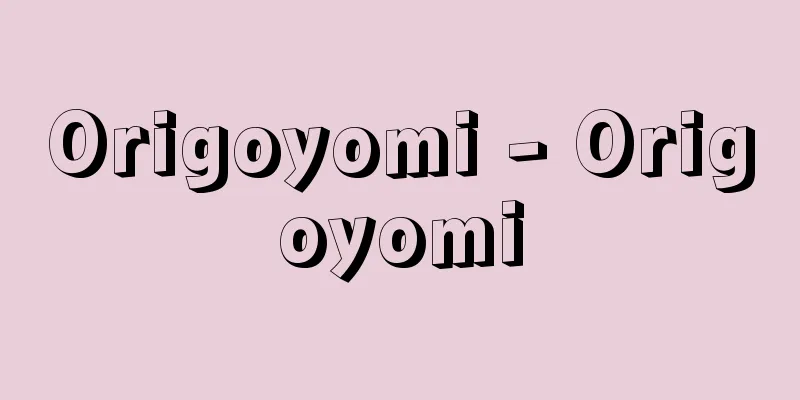Edokko - Edokko

|
Residents of Edo or citizens of Edo were called Edomono, and among them, native Edo residents and genuine Edo citizens were called Edokko. To be an Edokko, both parents had to be citizens for three generations. Narrowing it down like this, Edokko made up only about 10% of the 500,000 townspeople population of Edo during the Kyoho era (1716-1736). The word "Edokko" first appeared in a 1771 (Meiwa 8) senryu poem, "Edokko no waranji wo hakurangashisa." After the establishment of Edo in 1603 (Keicho 8), many ronin and others flowed in from all over the country and infiltrated the Edo city. After about a century and a half of being pioneers in each town, they accumulated wealth and became mature townspeople. Around that time, the sense of solidarity among Edo citizens as people from the same hometown became stronger, and the word "Edokko" began to appear. Also, because this feeling of the word matched their temperament, it became popular during the prosperous Edo period after the Kansei era (1789-1801). The characteristics of this Edokko include a cool and courageous spirit, a straightforward attitude, clarity of speech, and no attachment to money, as well as a tendency to be thoughtless and quick to quarrel. "I stare at the golden shachihoko, take my first bath in tap water, eat pounded rice, and am a gold leaf Edokko who grew up in the middle of Nihonbashi..." is a self-praise derived from a line in a play. Although they are proud of living in the foothills of the Shogun family, they also have a strong temperament that includes an exclusive pride, shows off, and is stubborn. The economic structure of Edo was intertwined with vested interests, giving birth to a newly wealthy class that was quick to grab the profits of the city, and the wasteful and squandering aspects of this wealth were emphasized. The frequent fires caused by Edo's urban structure frightened the wealthy merchants. However, the working class was not affected by disasters as much, their labor banks increased, and they benefited from the economic recovery, so there was no need to hold onto money the night before. Carpenters, plasterers, scaffolders, and peddlers carrying a pole on their shoulders all became increasingly aware of the fact that they were Edokko, and it was from the Bunsei era (1818-1830) that they began to wield their "Edokko" title as their only source of pride and exerted themselves. [Fumio Inagaki] "The Complete Works of Mitamura Engyo, Volume 7" (1975, Chuokoron-Shinsha)" ▽ "The Shape of Edo" by Saito Ryuzo (1936, Yuzankaku Publishing)" ▽ "Edokko" by Ishimoda Shun (1966, Togensha)" ▽ "Edokko" by Nishiyama Matsunosuke (1980, Yoshikawa Kobunkan) Source: Shogakukan Encyclopedia Nipponica About Encyclopedia Nipponica Information | Legend |
|
江戸居住者ないし江戸市民は江戸者と称し、そのなかでも生え抜きの江戸者、生粋(きっすい)の江戸市民を江戸っ子といった。江戸っ子は父母ともに3代続きの市民であることが必要条件とされた。このように絞ると、享保(きょうほう)年間(1716~36)の江戸町人人口50万のうち、江戸っ子はざっと10%にしかならなかった。「江戸っ子」ということばの初見は1771年(明和8)の川柳(せんりゅう)で、「江戸っ子のわらんじをはくらんがしさ」である。1603年(慶長8)江戸開府後、各地から浪人者その他が多数流入して江戸市井に入り込み、各町の草分けとなってから約1世紀半もたつと、蓄財も進み成長した町人ができてきた。そのころになると江戸市民の間に同郷的連帯感が強まってくるし、「江戸っ子」ということばがみられるようになる。またこの語感が彼らの気質にもあったために、寛政(かんせい)(1789~1801)以後の江戸繁栄期に普及した。 この江戸っ子の特徴としてあげられるのは、粋(いき)で勇み肌の気風、さっぱりとした態度、歯切れのよさ、金銭への執着のなさなどがあり、また浅慮でけんかっ早い点もある。「金の鯱鉾(しゃちほこ)をにらんで、水道の水を産湯(うぶゆ)に浴び、おがみ搗(づ)きの米を食って、日本橋の真ん中で育った金箔(きんぱく)つきの江戸っ子だ……」が、芝居の台詞(せりふ)からきた自賛の弁。将軍家のお膝元(ひざもと)に住むという自負のある反面、排他的な誇りを含み、見栄(みえ)を張り、意地を張るという気質も強い。 江戸の経済構造が利権にからみ、ぬれ手で粟(あわ)のつかみ取りといった新興富裕層を生み、それを浪費、蕩尽(とうじん)する一面が強調され、また江戸の都市構造上頻繁に起こる火事は大商人をおびえさせた。しかし勤労層は災害もあまり苦にならず、労銀もあがり、復興景気の恩恵にあずかれるとなれば、宵越しの金をもつ必要もなかった。大工、左官、鳶(とび)の者、天秤棒(てんびんぼう)を肩にして行商する連中などの、「俺(おれ)たちゃ江戸っ子だ」という意識が強くなり、それを唯一の誇りとして「江戸っ子」を振り回して力みだしたのは文政(ぶんせい)(1818~30)のころからである。 [稲垣史生] 『『三田村鳶魚全集 第7巻』(1975・中央公論社)』▽『斉藤隆三著『江戸のすがた』(1936・雄山閣出版)』▽『石母田俊著『江戸っ子』(1966・桃源社)』▽『西山松之助著『江戸っ子』(1980・吉川弘文館)』 出典 小学館 日本大百科全書(ニッポニカ)日本大百科全書(ニッポニカ)について 情報 | 凡例 |
>>: Edo Sodachi Festival Sashichi
Recommend
White, Shaun
Born: September 3, 1986. San Diego, California. An...
Mino [city] - Mino
A city in central Gifu Prefecture. It was incorpor...
Durham's Report
It was officially called Lord Durham's Report ...
Corned beef - konbi-fu (English spelling) corned beef
A type of salted beef product. Until the 17th cen...
Anna Magnani
...This attitude of facing reality and focusing o...
Jaén (English spelling)
The capital of Jaén Province in the Andalusia reg...
Bunzo - Bunzo
The title of a Kyogen piece. In the Okura school,...
Substitute
This is a classic Rakugo piece. It is also called ...
Airspace forecast - Kuukiyoho
…The Japan Meteorological Agency collects and exc...
Dalmatia (English spelling)
A province of the Roman Empire, the area inhabited...
Kinoshita [town] - Kioroshi
...A city in the northwest of Chiba Prefecture. I...
Pledge of claims - Forderungspfandrecht
A pledge established on a claim. A type of pledge ...
murid (English spelling)
...Its manifestations can be seen in the Sanusi s...
Tunghan
…A name of Eastern Turkish origin referring to th...
Fugitive - Ochiudo
Kabuki dance drama. Kiyomoto. The original title ...









